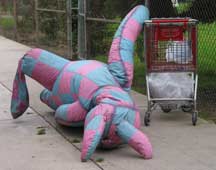Last week I played tennis with a friend who is a better player than I am so he gives me 2 games per set as a handicap. It used to be 3 games but I improved enough to drop it to 2. This week, though, he asked if we could move the handicap back up to 3 games because he plays better when he’s behind. I was so upset by his request that I broke down in tears on the court. I imagined Tom Hanks running out onto the court, putting his his hands on his hips and yelling at me, “There’s no crying in tennis!”
This week we played again and I got so mad about losing that I smashed my racket on the court and now it has a crack in it.
Then I lost to a crafty junkster and as I got to the bottom of a forward bend while I was doing my yoga practice after the match, I broke down in sobs.
What is going on here?
Crafty junksters don’t care how awkward they look. They don’t care if their backhand makes them look like they’re swatting flies. They don’t care if they can barely get their racket above their shoulder when they serve. No, all they care about is putting the ball where you are not. Many of them move terribly. One guy in my league has a limp for heaven’s sake, but he toys with hard hitters and frustrates the hell out of more athletic players because he gets the ball back with a lot of junk on it in and puts it in hard to reach places.
I was so tired of losing to junksters that I had a tennis lesson with my instructor, Sean Brawley, in late January
Sean told me that I could beat crafty junksters by just thinking about getting the ball over the net. Not only that, but most of the time, that is 90% of the work. You might need strategy at times: hit to your opponent’s weak side for instance or hit down the middle to take away the angle, but mostly, just get the ball over the net.

When we worked on this in the lesson, I got ninety five percent of the balls across the net. The exercise also uncovered a habit that is probably losing me a lot of points. I like to come to the net at the slightest hint of a short ball. A true recipe for disaster if you are only 5’4”. If the ball is beyond my service line, even if it is well in front of me, I should hit it over the net and then retreat to the baseline.
Sean explained it this way: first aim for consistency, then placement, then power. Once you can consistently get the ball over the net you can think about putting it in a particular place and only after that think about hitting it harder.
And now I’m a complete mess.

After Tiger Woods won the 1997 Master Tournament, he changed his golf swing. It took him over a year to feel comfortable with the change. After knee surgery in 2002, Woods changed his swing again and just now seems to feel comfortable with it. I don’t think Tiger broke down in tears on the golf course but I guarantee you he wanted to.
I’m used to thinking about attacking not just getting the ball over the net. At the slightest hint of trouble, i.e. the first game I lose, I revert to attacking and the ball goes into the net. Attacking should come in the flow of the game. If you force it, you will end up in a bad position. Undergoing a change in thinking is like going through a phase change. When ice melts or water boils, there is a stage of complete chaos before the material settles into its new state.
I could continue to play low percentage tennis and stay at my current level or I could hang in there through a few more smashed rackets and temper tantrums and learn to hit the ball consistently which should improve my game in the long term.
 I drove down to the
I drove down to the  It was a relatively sedate, sparse crowd despite the party atmosphere. There was a band, there were performers on stilts, acrobats and clowns and you could get the American flag painted on your face if you liked.
It was a relatively sedate, sparse crowd despite the party atmosphere. There was a band, there were performers on stilts, acrobats and clowns and you could get the American flag painted on your face if you liked. Ljubicic broke Agassi in the second game. Agassi broke back to get to 3-4 then immediately lost his serve and Ljubicic served out to win the first set 6-3.
Ljubicic broke Agassi in the second game. Agassi broke back to get to 3-4 then immediately lost his serve and Ljubicic served out to win the first set 6-3.